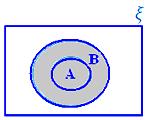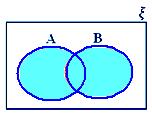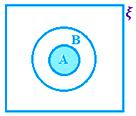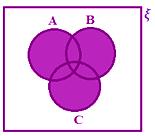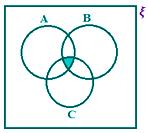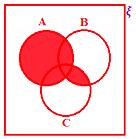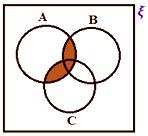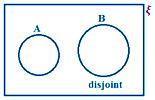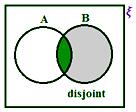Relationship in Sets using Venn Diagram
The relationship in sets using Venn diagram are discussed below:
• The union of two sets can be represented by Venn diagrams by the shaded region, representing A ∪ B.
A ∪ B when A ⊂ B
A ∪ B when neither A ⊂ B nor B ⊂ A
A ∪ B when A and B are disjoint sets
• The intersection of two sets can be represented by Venn diagram, with the shaded region representing A ∩ B.
A ∩ B when A ⊂ B, i.e., A ∩ B = A
A ∩ B when neither A ⊂ B nor B ⊂ A
A ∩ B = ϕ No shaded part
• The difference of two sets can be represented by Venn diagrams, with the shaded region representing A – B.
A – B when neither A ⊂ B nor B ⊂ A
A – B when A and B are disjoint sets.
Here A – B = A
A – B when A ⊂ B
Here A – B = ϕ
Relationship between the three Sets using Venn Diagram
• If ξ represents the universal set and A, B, C are the three subsets of the universal sets. Here, all the three sets are overlapping sets.
Let us learn to represent various operations on these sets.
A ∪ B ∪ C
A ∩ B ∩ C
Some important results on number of elements in sets and their use in practical problems.
Now, we shall learn the utility of set theory in practical problems.
If A is a finite set, then the number of elements in A is denoted by n(A).
Relationship in Sets using Venn Diagram
Let A and B be two finite sets, then two cases arise:
Case 1:
A and B are disjoint.
Here, we observe that there is no common element in A and B.
Therefore, n(A ∪ B) = n(A) + n(B)
Case 2:
When A and B are not disjoint, we have from the figure
(i) n(A ∪ B) = n(A) + n(B) – n(A ∩ B)
(ii) n(A ∪ B) = n(A – B) + n(B – A) + n(A ∩ B)
(iii) n(A) = n(A – B) + n(A ∩ B)
(iv) n(B) = n(B – A) + n(A ∩ B)
A – B
B – A
A ∩ B
Let A, B, C be any three finite sets, then
n(A ∪ B ∪ C) = n[(A ∪ B) ∪ C]
= n(A ∪ B) + n(C) – n[(A ∪ B) ∩ C]
= [n(A) + n(B) – n(A ∩ B)] + n(C) – n [(A ∩ C) ∪ (B ∩ C)]
= n(A) + n(B) + n(C) – n(A ∩ B) – n(A ∩ C) – n(B ∩ C) + n(A ∩ B ∩ C)
[Since, (A ∩ C) ∩ (B ∩ C) = A ∩ B ∩ C]
Therefore, n(A ∪B ∪ C) = n(A) + n(B) + n(C) – n(A ∩ B) – n(B ∩ C) – n(C ∩ A) + n(A ∩ B ∩ C)
